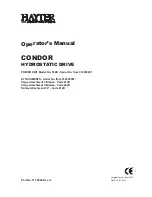
11
OMP-132/D
The speed of the engine was carefully adjusted at the
factory so that the generator produces the proper voltage
and frequency. For normal usage, the speed setting should
not be changed. If the generator is being run continuously
on a very light load, it is often advisable to lower the
operating speed slightly.
The engine will govern itself at full speed. Intentionally
overriding the governor and operating the generator at
low voltage may damage both the generator and any load
connected to it. Running the engine at excessively high
speeds results in high voltage, which may significantly
shorten the life of light bulbs and appliances being used, as
well as possibly damaging the engine.
CAUTION: EQUIPMENT DAMAGE
SPEED ADJUSTMENTS SHOULD ONLY BE MADE BY A
QUALIFIED SERVICE TECH. Whenever making any speed
adjustments, check the YourGen meter and be sure the
voltage and speed are correct.
Output voltage should be checked periodically to ensure
continued proper operation of the generating plant and
appliances.
Hz -
This is the measured frequency of the generator set. See
the table in the RPM section above for an explanation of
voltage and frequency ranges under load.
V1 -
Output voltage of Line 1 (L1 on panel) to neutral. See the
Load vs. Output table for an explanation of voltage and
frequency ranges under load.
V2 -
Output voltage of Line 2 (L2 on panel) to neutral. See the
Load vs. Output table for an explanation of voltage and
frequency ranges under load.
V1-V2 -
Output voltage of Line 1 (L1) and Line 2 (L2). See the
Load vs. Output table for an explanation of voltage and
frequency ranges under load.
Hours -
This displays the total running hours of the generator set.
When the generator is turned off, the hours will remain
displayed. The display is run on a CR2032, ten-year battery.
Once the unit is running, the battery connected to the unit
will then supply the power to the YourGen meter.
Load Bars -
These bars indicate how much load is being used on Line 1
(L1) and Line 2 (L2).
= 1-25% = 25-50%
= 50-75% = 75-100%
It is good practice to monitor the YourGen Meter when
applying load.
This will ensure the generator is balanced.
Balanced Unbalanced
120 Volt and 240 Volt receptacles are provided for
connection to various loads.
The diagram below represents this 9,600 watt (rated
output) generator. A & B represent the 120 volt output legs
of this generator. Up to 4,800 watts at 120 volts (40 Amps)
can be drawn from the receptacles attached to either A
or B output legs. This generator is capable of producing
40 Amps of 240 volt current at C. Check the appliance
or tool nameplates for the current and voltage to insure
compatibility. Remember that power taken from C reduces
the power available equally at both A and B and vice versa.
Change Oil Warning -
After the first 50 hours, the engine oil should be changed.
The YourGen meter will light up the oil icon ( ) and the
word ‘change’ will flash. Once the oil has been changed,
press and hold the cycle button for approximately 5
seconds until the warning has been removed from the
display to reset the warning. The meter will then remind
you of oil changes on the appropriate schedule for your
generator. It is important to remember that the engine
manufacturer recommends changing the oil on a calendar
schedule even if the total number of operational hours have
not been reached. Certain operating environments may
also require more frequent oil changes.
Alarms -
The display will start blinking and toggle to the first
parameter that is out of specification. The panel will remain
flashing until the fault condition returns to within the
acceptable range, see following table.
Acceptable Range
Frequency
57-63 Hz
Voltage
110VAC-130VAC
VAC1-VAC2
220VAC-260VAC
Battery -
When the unit is off, the YourGen meter will display the
hours continuously using a coin cell back-up battery inside
the meter. Once the unit is running, the meter will get
power from the main unit battery.
Voltage
3.0V DC
Battery Type
CR2032
Lifetime
10
Years
The battery has a 10 year lifetime, in the event you need to
change the battery, follow these instructions:
The battery is located in the control box near potentially live
AC terminals. To prevent electrocution while changing the
battery disable the unit by disconnecting the main battery,
spark plug and then open the receptacle panel. Locate the


































